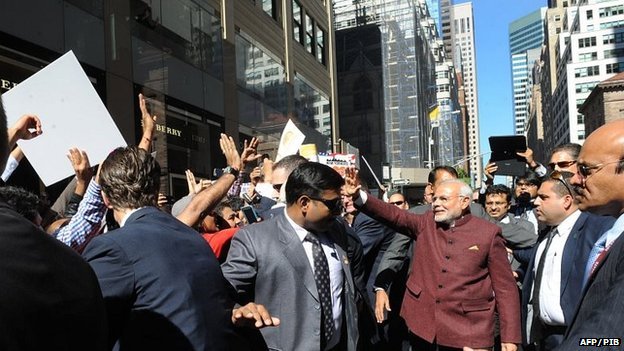Modi’s Look East Policy Approach is Finding Traction

Please note that we are not authorised to provide any investment advice. The content on this page is for information purposes only.
Active interest by India’s new leadership has provided an adrenaline shot to the flagging discourse on South Asian regionalism. During interactions with South Asian leaders on the sidelines of the United Nations General Assembly meeting in New York, Modi reiterated the need for greater regional integration in South Asia. This was in consonance with his Neighbours First policy, first initiated with invitations to South Asian heads of state to attend his swearing-in ceremony in May 2014.
Active interest by India’s new leadership has provided an adrenaline shot to the flagging discourse on South Asian regionalism. During interactions with South Asian leaders on the sidelines of the United Nations General Assembly meeting in New York, Modi reiterated the need for greater regional integration in South Asia. This was in consonance with his Neighbours First policy, first initiated with invitations to South Asian heads of state to attend his swearing-in ceremony in May 2014.
The South Asian region is assuming primacy in Modi’s foreign policy. Modi’s first day in office was dedicated exclusively to bilateral meetings with fellow leaders of the SAARC countries (Afghanistan, Bangladesh, Bhutan, Sri Lanka, Nepal, Pakistan, and the Maldives). His first state visit was to Bhutan and then Nepal. During visits abroad and even when engaging with domestic audience, Modi has stressed the need for greater regional cooperation.
Moreover, Modi’s approach is finding traction. Nepal’s foreign minister Mahendra Bahadur Pandey recently visited India to invite Modi to the South Asian Association for Regional Cooperation (SAARC) summit in November in Kathmandu. Pandey reportedly noted that the SAARC summit would be taking place in the ‘changed’ context of India’s new Neighbours First policy.
This proactive approach from India, the largest country in the region, is critical for the success of South Asian integration and needs welcoming. Nevertheless, there are many challenges that confront SAARC-based regional cooperation measures.
Conflict in the Afghanistan–Pakistan region is one. During the Cold War, Pakistan was a frontline state in the fight against communism. Now the region is an epicentre of global terrorism. This poses many challenges for India. How does one integrate with a region experiencing violent instability? When elements in Pakistan’s state apparatus — such as intelligence agencies and the military — have a predisposition to indulge in proxy wars, it is only natural that regional integration often causes anxiety for Indian policy makers.
As armed non-state actors gain strength, the capacities of Pakistan’s state apparatus are becoming questionable. Terrorist organisations in Pakistan have graduated from attacking military installations to higher-level military operations. This was clear by an attempt to hijack a naval frigate in Karachi in September. With terrorist organisations in Pakistan demonstrating greater reach and complex planning abilities, concerns remain about potential security and political costs of seamless physical connectivity.
Proponents of enhanced regional integration argue that the prosperity created by increased trade and potential knock-on effects for peace in Pakistan mean the risks associated with the connectivity agenda are worth taking. However, this is at least debatable.
It takes more than just trade to ignite growth, and it may be erroneous to assume that increased trade with India will see Pakistan’s economic growth lifted sufficiently for it to deal with its security problems. Reforms required for regional integration lag the benefits that accrue. It may be unrealistic to expect Pakistan’s leaders to hold the line in the meantime.
With the Afghanistan–Pakistan region experiencing violent instability, the locus of South Asian cooperation is shifting east. Countries have started experimenting with multiple frameworks of regional integration such as the Bay of Bengal Initiative for Multi-Sectoral Technical and Economic Cooperation (BIMSTEC). BIMSTEC does not include Afghanistan and Pakistan but it connects other South Asian countries with Southeast Asian counterparts.
The Bangladesh, China, India and Myanmar Forum for Regional Cooperation (BCIM) is also finding traction. Nevertheless, the problem of India and China’s longstanding border dispute — that bedevilled the SAARC framework — also comes into play in BCIM.
Conversely, BIMSTEC completely lacks territorial disputes and power asymmetry is relatively mild. BIMSTEC can also act as a fulcrum for the connectivity and economic corridors that are being conceptualised by Japan and the US. Recently, Japan’s Prime Minister Shinzo Abe called for a Bay of Bengal Industrial Growth Belt (BIG-B) to act as a platform for bringing countries together. Similarly, the US is articulating an Indo-Pacific Economic Corridor integrating South Asian and economically vibrant Southeast Asian economies. The BIMSTEC framework is geographically well defined and has greater dynamism because of its eclectic membership and inter-regional content.
India’s new leaders should recognise the logic of these economic and political regional forces and look to the BIMSTEC framework to hasten its eastward shifting locus of regional integration.
India’s look east policy needs a multilateral vantage point is republished with permission from East Asia Forum




